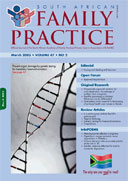Homemade sugar-salt solution for oral rehydration: Knowledge of mothers and caregivers.
Abstract
Background: Worldwide, it is estimated, that more than two million children under the age of five die annually as a result of gastroenteritis with dehydration. Up to 95% of these cases can be treated successfully with oral rehydration therapy. The aim of the study was to evaluate caregivers’ knowledge of, attitudes to and use of homemade sugar and salt solution (SSS) in order to address the shortfalls. Differences between the knowledge, attitudes and practices in urban, rural and very rural areas were also investigated. Method: Three different studies were performed. All three were descriptive cross-sectional studies. During the research period,all mothers/caregivers who brought children to the hospital or clinic were asked to fill in a questionnaire. All participants who gave informed consent were selected consecutively for the duration of the different studies. Results: A total of 597 caregivers were included in the study. Knowledge of the existence of SSS (88-94%) and the wide use of SSS in 78 to 90% of diarrhoea cases do not guarantee the correct use of it. Fewer than half of all caregivers could mix the correct solution. Conclusions: Healthcare workers should make sure that everybody knows about the correct use of SSS by means of printed information and the informal and formal training of caregivers and scholars. The correct use of homemade SSS could save millions of lives. (SA Fam Pract 2005;47(2): 51-53)
Published
2005-03-01
Section
Original Research
By submitting manuscripts to SAFP, authors of original articles are assigning copyright to the South African Academy of Family Physicians. Copyright of review articles are assigned to the Publisher, Medpharm Publications (Pty) Ltd, unless otherwise specified. Authors may use their own work after publication without written permission, provided they acknowledge the original source. Individuals and academic institutions may freely copy and distribute articles published in SAFP for educational and research purposes without obtaining permission.

